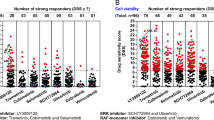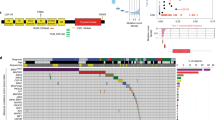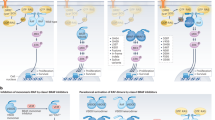Abstract
Histiocytic neoplasms are a heterogeneous group of clonal haematopoietic disorders that are marked by diverse mutations in the mitogen-activated protein kinase (MAPK) pathway1,2. For the 50% of patients with histiocytosis who have BRAFV600 mutations3,4,5, RAF inhibition is highly efficacious and has markedly altered the natural history of the disease6,7. However, no standard therapy exists for the remaining 50% of patients who lack BRAFV600 mutations. Although ERK dependence has been hypothesized to be a consistent feature across histiocytic neoplasms, this remains clinically unproven and many of the kinase mutations that are found in patients who lack BRAFV600 mutations have not previously been biologically characterized. Here we show ERK dependency in histiocytoses through a proof-of-concept clinical trial of cobimetinib, an oral inhibitor of MEK1 and MEK2, in patients with histiocytoses. Patients were enrolled regardless of their tumour genotype. In parallel, MAPK alterations that were identified in treated patients were characterized for their ability to activate ERK. In the 18 patients that we treated, the overall response rate was 89% (90% confidence interval of 73–100). Responses were durable, with no acquired resistance to date. At one year, 100% of responses were ongoing and 94% of patients remained progression-free. Cobimetinib treatment was efficacious regardless of genotype, and responses were observed in patients with ARAF, BRAF, RAF1, NRAS, KRAS, MEK1 (also known as MAP2K1) and MEK2 (also known as MAP2K2) mutations. Consistent with the observed responses, the characterization of the mutations that we identified in these patients confirmed that the MAPK-pathway mutations were activating. Collectively, these data demonstrate that histiocytic neoplasms are characterized by a notable dependence on MAPK signalling—and that they are consequently responsive to MEK inhibition. These results extend the benefits of molecularly targeted therapy to the entire spectrum of patients with histiocytosis.
This is a preview of subscription content, access via your institution
Access options
Access Nature and 54 other Nature Portfolio journals
Get Nature+, our best-value online-access subscription
$29.99 / 30 days
cancel any time
Subscribe to this journal
Receive 51 print issues and online access
$199.00 per year
only $3.90 per issue
Buy this article
- Purchase on Springer Link
- Instant access to full article PDF
Prices may be subject to local taxes which are calculated during checkout


Similar content being viewed by others
Data availability
All datasets generated and/or analysed during the current study, including patient-level clinical data as well as all sequencing data have been deposited and are publicly available in the cBioPortal for Cancer Genomics under the accession code ‘Histiocytosis Cobimetinib (MSK, Nature 2019)’ (https://www.cbioportal.org/study?id=histiocytosis_cobi_msk_2019).
References
Haroche, J. et al. Histiocytoses: emerging neoplasia behind inflammation. Lancet Oncol. 18, e113–e125 (2017).
Allen, C. E., Merad, M. & McClain, K. L. Langerhans-cell histiocytosis. N. Engl. J. Med. 379, 856–868 (2018).
Badalian-Very, G. et al. Recurrent BRAF mutations in Langerhans cell histiocytosis. Blood 116, 1919–1923 (2010).
Haroche, J. et al. High prevalence of BRAF V600E mutations in Erdheim–Chester disease but not in other non-Langerhans cell histiocytoses. Blood 120, 2700–2703 (2012).
Emile, J. F., Charlotte, F., Amoura, Z. & Haroche, J. BRAF mutations in Erdheim–Chester disease. J. Clin. Oncol. 31, 398 (2013).
Hyman, D. M. et al. Vemurafenib in multiple nonmelanoma cancers with BRAF V600 Mutations. N. Engl. J. Med. 373, 726–736 (2015).
Diamond, E. L. et al. Vemurafenib for BRAF V600-mutant Erdheim–Chester disease and Langerhans cell histiocytosis: analysis of data from the histology-independent, phase 2, open-label VE-BASKET Study. JAMA Oncol. 4, 384–388 (2018).
Diamond, E. L. et al. Diverse and targetable kinase alterations drive histiocytic neoplasms. Cancer Discov. 6, 154–165 (2016).
Brown, N. A. et al. High prevalence of somatic MAP2K1 mutations in BRAF V600E-negative Langerhans cell histiocytosis. Blood 124, 1655–1658 (2014).
Chakraborty, R. et al. Mutually exclusive recurrent somatic mutations in MAP2K1 and BRAF support a central role for ERK activation in LCH pathogenesis. Blood 124, 3007–3015 (2014).
Emile, J. F. et al. Recurrent RAS and PIK3CA mutations in Erdheim–Chester disease. Blood 124, 3016–3019 (2014).
Nelson, D. S. et al. Somatic activating ARAF mutations in Langerhans cell histiocytosis. Blood 123, 3152–3155 (2014).
Chakraborty, R. et al. Alternative genetic mechanisms of BRAF activation in Langerhans cell histiocytosis. Blood 128, 2533–2537 (2016).
Cohen Aubart, F. et al. Targeted therapies in 54 patients with Erdheim–Chester disease, including follow-up after interruption (the LOVE study). Blood 130, 1377–1380 (2017).
Jacobsen, E., Shanmugam, V. & Jagannathan, J. Rosai–Dorfman disease with activating KRAS mutation—response to cobimetinib. N. Engl. J. Med. 377, 2398–2399 (2017).
Gounder, M. M., Solit, D. B. & Tap, W. D. Trametinib in histiocytic sarcoma with an activating MAP2K1 (MEK1) mutation. N. Engl. J. Med. 378, 1945–1947 (2018).
Diamond, E. L. et al. Consensus guidelines for the diagnosis and clinical management of Erdheim–Chester disease. Blood 124, 483–492 (2014).
Abla, O. et al. Consensus recommendations for the diagnosis and clinical management of Rosai–Dorfman–Destombes disease. Blood 131, 2877–2890 (2018).
Allen, C. E., Ladisch, S. & McClain, K. L. How I treat Langerhans cell histiocytosis. Blood 126, 26–35 (2015).
Eisenhauer, E. A. et al. New response evaluation criteria in solid tumours: revised RECIST guideline (version 1.1). Eur. J. Cancer 45, 228–247 (2009).
Arnaud, L. et al. CNS involvement and treatment with interferon-α are independent prognostic factors in Erdheim–Chester disease: a multicenter survival analysis of 53 patients. Blood 117, 2778–2782 (2011).
Rosen, L. S. et al. A first-in-human phase I study to evaluate the MEK1/2 inhibitor, cobimetinib, administered daily in patients with advanced solid tumors. Invest. New Drugs 34, 604–613 (2016).
Larkin, J. et al. Combined vemurafenib and cobimetinib in BRAF-mutated melanoma. N. Engl. J. Med. 371, 1867–1876 (2014).
Falchook, G. S. et al. Activity of the oral MEK inhibitor trametinib in patients with advanced melanoma: a phase 1 dose-escalation trial. Lancet Oncol. 13, 782–789 (2012).
Pratilas, C. A. et al. Genetic predictors of MEK dependence in non-small cell lung cancer. Cancer Res. 68, 9375–9383 (2008).
Solit, D. B. et al. BRAF mutation predicts sensitivity to MEK inhibition. Nature 439, 358–362 (2006).
Gao, Y. et al. Allele-specific mechanisms of activation of MEK1 mutants determine their properties. Cancer Discov. 8, 648–661 (2018).
Emery, C. M. et al. MEK1 mutations confer resistance to MEK and B-RAF inhibition. Proc. Natl Acad. Sci. USA 106, 20411–20416 (2009).
Cheng, D. T. et al. Memorial Sloan Kettering-Integrated Mutation Profiling of Actionable Cancer Targets (MSK-IMPACT): a hybridization capture-based next-generation sequencing clinical assay for solid tumor molecular oncology. J. Mol. Diagn. 17, 251–264 (2015).
Durham, B. H. et al. Genomic analysis of hairy cell leukemia identifies novel recurrent genetic alterations. Blood 130, 1644–1648 (2017).
Zheng, Z. et al. Anchored multiplex PCR for targeted next-generation sequencing. Nat. Med. 20, 1479–1484 (2014).
Acknowledgements
We thank the patients and their families for participating in this study. We thank Z. J. Tang for assisting with whole-exome genomic analysis and R. Kundra for assisting with the cBioPortal. This work was supported by Genentech and grants from the Histiocyte Society, the Erdheim–Chester Disease Global Alliance, the Functional Genomics Initiative of Memorial Sloan Kettering Cancer Center, the Society of Memorial Sloan Kettering Cancer Center, the Histiocytosis Association, the Translational and Integrative Medicine Award of Memorial Sloan Kettering Cancer Center, the Geoffrey Beene Center of Memorial Sloan Kettering Cancer Center, the American Society of Hematology, the Leukemia & Lymphoma Society, Frame Fund, Nonna’s Garden Foundation and National Institutions of Health (P30 CA008748, 1 R01 CA201247 and K08 CA218901).
Reviewer information
Nature thanks Barrett Jon Rollins and the other anonymous reviewer(s) for their contribution to the peer review of this work.
Author information
Authors and Affiliations
Contributions
E.L.D., O.A.-W. and D.M.H. designed the study. M.K., L.B. and H.C. processed all patient material for isolation of DNA and RNA for genomic analyses. B.H.D. cloned all cDNA and performed in vitro studies of their effects on cell growth and signalling under the supervision of N.R. and O.A.-W. B.H.D. also analysed genomic data under the supervision of O.A.-W. J.B. collected data and samples for processing by M.K., L.B. and H.C. E.L.D., J.H.F., R.R., M.L. and L.A.B. enrolled and treated the patients. E.D. and A.I. performed statistical analyses. G.A.U. and R.J.Y. evaluated all radiographic studies. E.L.D., B.H.D., N.O., A.D., O.A.-W. and D.M.H. analysed the clinical and laboratory data. E.L.D., B.H.D., O.A.-W. and D.M.H. prepared the manuscript with help from all co-authors. The study was designed jointly by E.L.D., B.H.D., O.A.-W. and D.M.H. The investigators collected and analysed the data. All authors had access to the data, and E.L.D., B.H.D., O.A.-W. and D.M.H. wrote the first draft of the manuscript. All the authors were involved in the data analysis and manuscript preparation. All the authors vouch for the completeness and accuracy of the data and analyses, and for the adherence to the study protocols. All the authors made the decision to submit the manuscript for publication.
Corresponding authors
Ethics declarations
Competing interests
The authors declare the following competing interests: E.L.D., grants from Erdheim–Chester Disease Global Alliance, The Histiocytosis Association, the Society of Memorial Sloan Kettering, the Translational and Integrative Medicine Award of Memorial Sloan Kettering, the American Society for Clinic Oncology, and the Frame Fund; B.H.D., grants from National Cancer Institute, American Society of Hematology and Erdheim–Chester Disease Global Alliance Foundation; G.U. personal fees from Sanofi and grants from Sanofi, Novartis and Genentech; R.J.Y., personal fees from Agios, PUMA, NordicNeuroLabs and Icon, and grants from Agios; R.R., personal fees from Incyte, Celgene, Agios, Jazz, BeyondSpring, Apexx and Partner Therapeutics, and research funding from Stemline and Constellation; M.L., personal fees and royalties from Roche/Genentech, and research funding from Veloce, Berg and US Biotest; A.D., personal fees from Roche, Corvus Pharmaceuticals, Physicians’ Education Resource, Seattle Genetics, Peerview Institute, Oncology Specialty Group, Pharmacyclics, Celgene and Novartis, and grants from National Cancer Institute and Roche; N.R., personal fees from Array BioPharma, Millennium Pharmaceuticals, AstraZeneca/MedImmune, Novartis, Eli Lilly, Boehringer Ingelheim, Merrimack Pharmaeutics, Chugai, Beigene, Daiichi Sankyo, Kura Oncology, ZAI Lab, F-Prime and Kadmon, and grants from Chugai, Bayer and Tarveda; A.I., personal fees from Mylan; O.A.-W., grants from National Cancer Institute, National Heart Lung and Blood Institute and H3B Biomedicine, and personal fees from H3B Biomedicine, Foundation Medicine, Merck and Jansen; D.M.H., personal fees from Atara Biotherapeutics, Chugai Pharma, Boehringer Ingelheim, AstraZeneca, Pfizer, Bayer, Debiopharm Group and Genetech, and grants from National Cancer Institute, AstraZeneca, Puma Biotechnology, Loxo Oncology, Bayer Pharmaceuticals, and The Nonna's Garden Foundation Initiative in Precision Oncology. The remaining authors have nothing to disclose.
Additional information
Publisher’s note: Springer Nature remains neutral with regard to jurisdictional claims in published maps and institutional affiliations.
Extended data figures and tables
Extended Data Fig. 1 Waterfall plot of maximum change in tumour size by RECIST after treatment with cobimetinib in patients with histiocytosis.
The upper and lower dotted lines represent cut-offs for progressive disease and partial response, respectively. Colours of bars indicate the genomic alteration present. Notations above bars indicate the specific mutation. One patient (marked by an asterisk) had undergone previous BRAF inhibitor therapy that was discontinued owning to intolerance. One patient (marked by a dagger) died owing to underlying disease. n = 14 patients in total.
Extended Data Fig. 2 PET-defined duration of response.
This graph depicts the duration of response according to PET criteria in the 16 patients that responded to treatment, beginning with date of initial response.
Extended Data Fig. 3 Histopathology of histiocytoses with activating mutations in MEK2, RAF1 and BRAF treated in this study.
a, Protein diagram (top) and histological images (bottom) from a patient with Erdheim–Chester disease with a MAP2K2Y134H mutation. b, Protein diagram (top) and histological images (bottom) from a patient with non-Langerhans cell histiocytosis with a RAF1K106N mutation. c, Protein diagram (top) and histological images (bottom) from a patient with Langerhans cell histiocytosis with a BRAFN486_T491delinsK mutation.
Extended Data Fig. 4 Study CONSORT diagram.
This diagram shows the flow of patients through all phases of study participation from enrolment and follow-up through to data analysis.
Supplementary information
Supplementary Information
This file contains source data for the gel images and the complete and unredacted clinical protocol (ClinicalTrials.gov, NCT02649972). Both the initial and final versions of the protocol are included. A summary of changes itemizes modifications that occurred between these two versions.
Rights and permissions
About this article
Cite this article
Diamond, E.L., Durham, B.H., Ulaner, G.A. et al. Efficacy of MEK inhibition in patients with histiocytic neoplasms. Nature 567, 521–524 (2019). https://doi.org/10.1038/s41586-019-1012-y
Received:
Accepted:
Published:
Issue Date:
DOI: https://doi.org/10.1038/s41586-019-1012-y
This article is cited by
-
Phase 2 study using low dose cytarabine for adult patients with newly diagnosed Langerhans cell histiocytosis
Leukemia (2024)
-
The role of CRAF in cancer progression: from molecular mechanisms to precision therapies
Nature Reviews Cancer (2024)
-
Diagnosis and Management of Dermatologic Adverse Events from Systemic Melanoma Therapies
American Journal of Clinical Dermatology (2023)
-
Treatment of Langerhans Cell Histiocytosis and Histiocytic Disorders: A Focus on MAPK Pathway Inhibitors
Pediatric Drugs (2023)
-
The clinical spectrum and prognostic factors of Erdheim-Chester disease and mixed Langerhans cell histiocytosis and Erdheim-Chester disease
Annals of Hematology (2023)
Comments
By submitting a comment you agree to abide by our Terms and Community Guidelines. If you find something abusive or that does not comply with our terms or guidelines please flag it as inappropriate.



